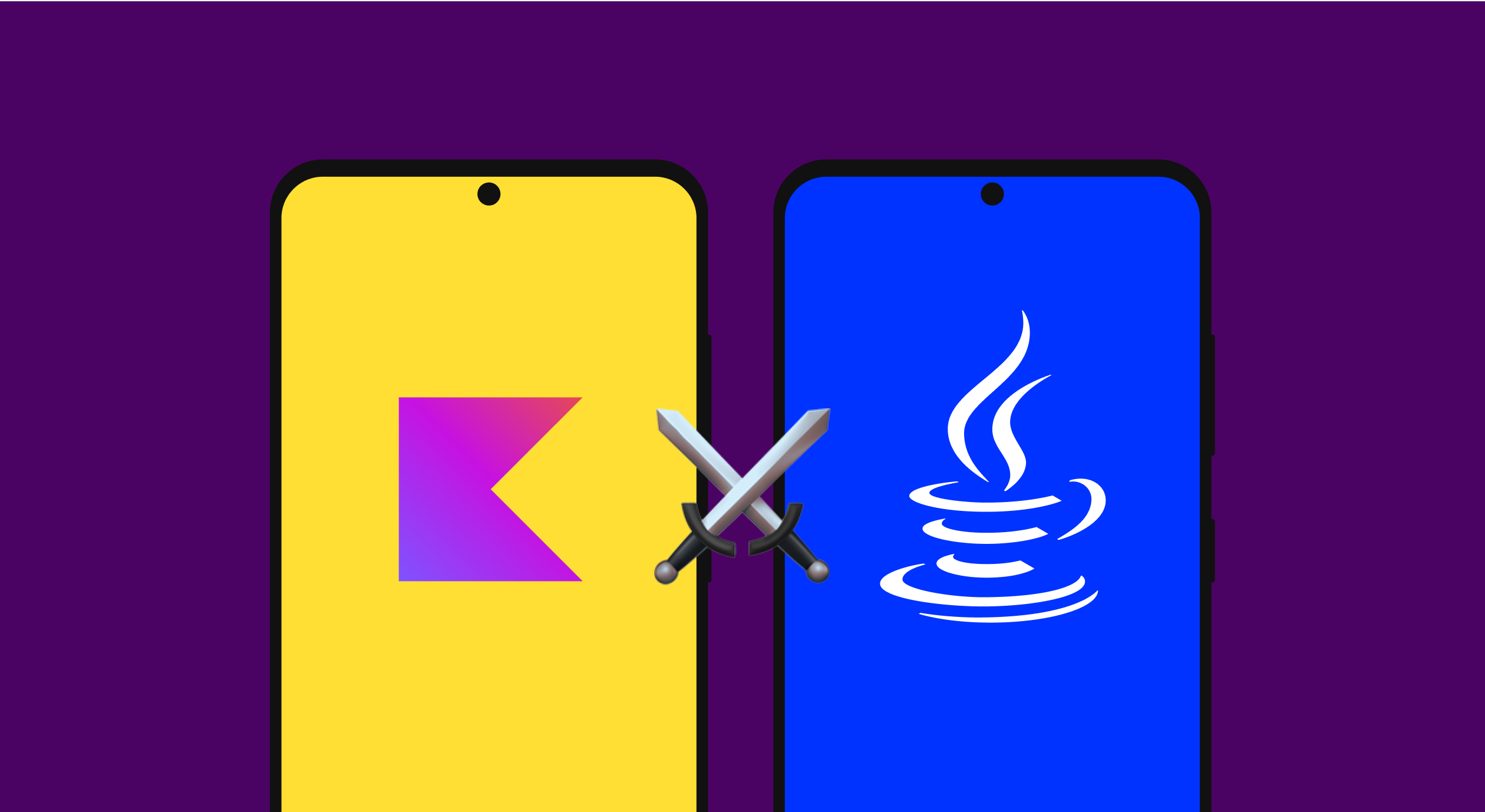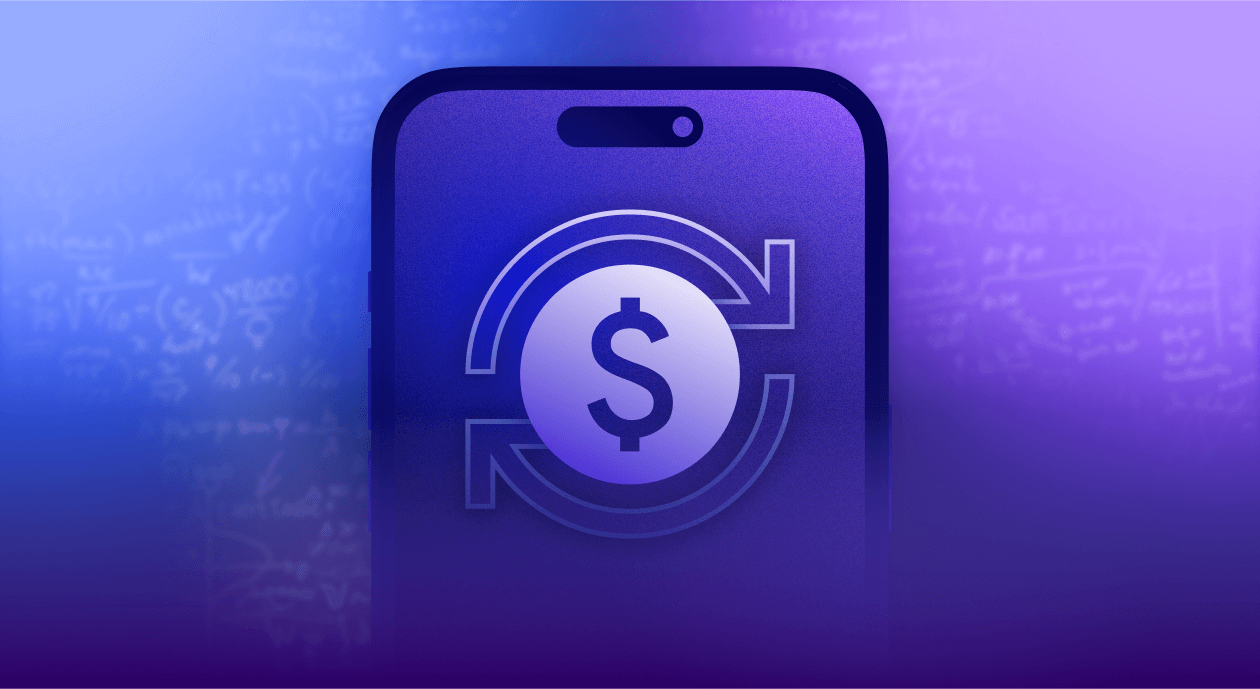Kotlin vs Java: Which is better for Android app development?

January 16, 2024
20 min read

For Android developers, the choice between Kotlin and Java is a critical decision. Kotlin, known for its modern features and efficiency, has been on the rise, especially since it has been endorsed by Google. Java, on the other hand, is an established language with a broad user base and extensive libraries.
In this article, we want to give you a thorough comparison of Kotlin and Java, focusing on the capabilities and limitations of the two languages, paying specific attention to how they might fit into your current development practices. If you can’t decide on which language to work with, this guide is for you.
What is Java
Created back in 1995, Java has been the go-to language for several waves of web and app developers. It has also been the key player in Android development since the beginning of the mobile OS, largely due to Google’s choice to use the language for its Android SDK. The language is respected for its object-oriented structure, essential for modular design in app development, and its platform independence, thanks to the Java Virtual Machine (JVM). When asked, developers are also quick to mention Java’s comparatively strong memory management and robust security features.
Over the years, Java developers have created an extensive ecosystem full of libraries, frameworks, and tools that aid faster development cycles and resource-rich problem-solving. While many new languages have emerged during Java’s existence, its stability, maturity, and widespread adoption keep it deeply ingrained in the Android development landscape, influencing many architectural and design patterns used today.
What is Kotlin
Introduced in 2011, Kotlin, a statically typed programming language, has swiftly gained prominence, revolutionizing software development. It is attributed to JetBrains, a Czech software developer renowned for its IDEs, that aimed to create a modern and efficient language fully interoperatable with Java, while also addressing its perceived shortcomings.
Kotlin’s quick adoption among developers can be attributed to its unique blend of features. Its design principles emphasized conciseness, readability, and expressiveness, decluttering Java’s ages-long detail-rich syntaxis. The ability to express complex concepts with fewer lines of code reduces development time and improves code maintainability. Open-source accessibility has enabled a vibrant community to contribute to its growth and foster a collaborative learning environment.
Interoperable with Java, Kotlin seamlessly integrates with existing Java codebases, allowing developers to use and build upon existing knowledge and libraries. This compatibility has been instrumental in its adoption by Google, which officially recognized Kotlin as a first-class language for Android app development in 2017, only to call it the preferred language two years later.
The adoption of Kotlin in the Android ecosystem has been particularly remarkable, with over 60% of apps on the Google Play Store now leveraging Kotlin. This surge in popularity stems from its ability to enhance the development process, leading to shorter development cycles, improved code quality, and a more maintainable codebase.
Kotlin vs. Java: detailed comparison
In this section, we go through the key differences between Kotlin and Java, two leading Android development programming languages. From language syntax to community support, we will go into detail trying to explain the strengths and weaknesses of each language.
Functions and Features
Kotlin and Java, while both popular for Android development, have distinct approaches to language design and features. Kotlin is recognized for its concise and straightforward syntax, making code more readable and maintainable. It includes modern features like coroutines, which allow for efficient multitasking without complex code and repetitive writing. Java, conversely, tends to be more wordy; however, it’s celebrated for its stability and comprehensive feature set, developed over many years. Its syntax is widely recognized and understood in the developer community, an advantage for teams already skilled in Java.
Thanks to its interoperability with Java, Kotlin’s integration into the Android development environment has been seamless. This means developers can use both Java and Kotlin within the same project without issues, providing flexibility in adopting Kotlin. While Java’s performance and reliability continue to make it a strong choice for large-scale applications, Kotlin’s modern capabilities and efficiency enhancements appeal to developers looking for a more streamlined and up-to-date coding experience.
Performance and Memory
When it comes to performance and memory usage, Kotlin and Java are similar since they both run on the Java Virtual Machine (JVM). This common platform means their basic performance metrics are often — but not always — comparable. For example, Kotlin’s more concise and expressive code can reduce the likelihood of bugs and streamline performance, particularly in simpler applications or those requiring modern programming features. The efficiency of Kotlin’s syntax often means writing less code to achieve the same functionality, which can translate to quicker execution in some scenarios.
On the other hand, Java has a long history of optimization for various types of applications, particularly those that are large and complex. This optimization can sometimes give Java an advantage in terms of performance, especially in scenarios that involve extensive data processing or require robust backend operations. Java’s mature ecosystem, featuring numerous performance-enhancing tools and libraries, allows developers to fine-tune their applications for optimal efficiency.
Null Safety
Null safety is the key aspect where Kotlin shines. This feature effectively reduces the chances of encountering the notorious null pointer exceptions that are common in Java. In Kotlin, variables can’t hold null values by default, and the language forces developers to explicitly declare a variable as nullable if it is intended to hold a null value. This proactive approach at the language level makes Kotlin code less prone to errors and enhances overall code reliability.
In contrast, Java handles null values differently, requiring developers to be more vigilant. Code written in Java often needs additional checks and balances to prevent null pointer exceptions, leading to more verbose and complex code. This extra coding not only increases the potential for error but also adds to the development workload, which makes Kotlin particularly appealing for developers looking for a more robust and secure coding experience.
Deployment
Kotlin and Java deploy applications similarly: they compile down to bytecode, making them compatible with the Java Virtual Machine (JVM). This means that at a basic level, the processes are quite parallel. However, Koltin’s additional language features, such as inline functions and lambda expressions, while enhancing the coding experience and capabilities, add extra steps to the compilation process. Thus, this language can experience marginally longer compilation times.
The compiled Kotlin code can also result in slightly larger package sizes than Java. This is because Kotlin’s syntax while easier and more efficient in the process, can add more bytecode after compilation. These differences in compile time and package size are typically small, but they can be significant for developers who are working on projects where every bit of efficiency and speed counts, especially in scenarios where rapid deployment and or small app size are crucial.
Documentation
Java, with its long history, has an extensive range of documentation available. This includes detailed official guides, a multitude of books (even printed ones!), comprehensive online tutorials, and a wealth of community-contributed content. All these resources make Java highly accessible for both beginners and experienced developers, offering solutions and knowledge for a wide array of programming scenarios. The depth and breadth of Java’s documentation make it one of the most thoroughly documented programming languages available, which can sometimes be daunting for newcomers.
Kotlin’s documentation, on the other hand, is limited to several official sources and is praised for its modernity and ease of understanding. The official documentation is clear and well-structured, focusing on practical applications and straightforward explanations. The Kotlin community, while not as big as Java’s, is actively producing a myriad of additional learning materials, including online courses and forums. These resources make learning Kotlin an efficient and user-friendly experience.
To see what Kotlin you might need to use to work with Adapty, take a look at our documentation.
Popularity
Kotlin’s popularity in the Android app development sphere has surged after Google’s endorsement as a preferred language for this platform. This support has significantly influenced developers’ inclination towards Kotlin, with more and more choosing the language for its modern features and efficient coding capabilities. Right now, more than 95% of the Top 1000 Android apps are written with Kotlin.
Despite this shift, Java holds a strong position among Android developers. Its long-established presence, coupled with a vast number of existing Java-based applications, ensures its ongoing relevance. Many organizations still maintain large Java codebases, and the language’s stability and performance continue to make it a viable choice for many projects. It’s also prominent in many educational curriculums from high schools to universities, which contributes to the sustained significance of the language.
Community and Support
Both Kotlin and Java have strong communities. Java’s community is larger and more established, with a wealth of forums, online resources, and community contributions accumulated over the years. Kotlin’s community, while smaller, is rapidly growing and is known for its enthusiasm and support, especially in the Android development sector. The engagement and resources available in these communities play a crucial role in ongoing learning and development support.
2024 subscription benchmarks and insights
Get your free copy of our latest subscription report to stay ahead in 2024.
Kotlin’s unique features (that Java doesn’t have)
Kotlin brings several unique features and advantages to the table, especially when compared to Java. These features not only enhance the development experience but also offer capabilities that Java lacks or handles less efficiently. Here’s the top 10:
- One of Kotlin’s most notable features is coroutines, which simplify asynchronous programming by allowing suspending functions to perform long-running tasks without blocking the main thread. This leads to more efficient handling of concurrency, a critical aspect in Android development for a smooth user experience.
- Kotlin introduces extension functions, allowing developers to extend existing classes with new functionality without inheriting from the class. This feature enables more readable and concise code and can lead to more intuitive APIs and utilities.
- As mentioned earlier, Kotlin’s approach to null safety is more advanced than Java’s. In Kotlin, nullability is a type system feature, that significantly reduces the risk of null pointer exceptions, one of the most common issues in Java applications. Variables in Kotlin are non-null by default, and the language forces developers to explicitly handle null cases, making the code safe and predictable.
- Kotlin’s syntax is more concise than Java’s. It reduces boilerplate code significantly, making the codebase more readable and maintainable. Features like data classes, type inference, and smart casts simplify common tasks and reduce the amount of code needed to express them.
- Unlike Java, Kotlin allows functions to have default arguments and named parameters, providing more flexibility and readability. This reduces the need for multiple overloaded functions and makes code more expressive.
- Kotlin’s smart cast feature automatically casts types if they have been checked in a control structure, which eliminates the need for explicit casting, making the code cleaner and less error-prone.
- Kotlin’s integration of lambdas and support for higher-order functions is more intrinsic to its design. While Java 8 did introduce lambdas, Kotlin’s approach is more fluid and integral to the language. This allows for a more natural and concise way of using lambdas and passing functions as parameters or returning them from other functions, resulting in a language that’s inherently more suited for functional programming.
- Kotlin can also be used as a scripting language: it can be run directly in the scripting environment without compiling to bytecode, which is not something Java traditionally offers. This allows developers to write and run scripts interactively, similar to scripting languages like Python or JavaScript, which is particularly useful for tasks like testing, exploring APIs, or writing build scripts.
- With structured concurrency, Kotlin provides a more disciplined and easier-to-understand approach to concurrency, reducing errors and making code more robust.
- While this is not a unique feature per se, Kotlin’s seamless interoperability with Java allows developers to gradually migrate from Java to Kotlin or use both languages within the same project. This is especially beneficial for large projects or teams transitioning to Kotlin.
Kotlin vs Java: Which is better for Android apps?
When choosing between Kotlin and Java, the decision largely depends on factors like app complexity, team expertise, project timeline, and existing resources. Here’s what you might need to consider:
App Complexity: For complex applications requiring advanced features like coroutines for efficient asynchronous tasks, Kotlin’s modern capabilities make it a more suitable choice. Its concise syntax and robustness can simplify the development of feature-rich apps. Java, on the other hand, might be preferable for less complex applications or when leveraging existing Java libraries and frameworks is crucial.
Team Expertise: If a development team is already proficient in Java, sticking with Java can be more efficient, especially for short-term projects. The learning curve for Kotlin might not justify the switch in such cases. However, for teams aiming to adopt modern programming paradigms or those starting fresh, Kotlin’s concise syntax and safety features could offer a steeper but rewarding learning curve.
Project Timeline: For projects with tight deadlines, the choice might depend on the team’s existing knowledge base. Java would be a safer bet for a Java-experienced team, avoiding the initial slowdown due to learning a new language. But if you’re a team of mostly beginners with no or little prior knowledge, learning and practicing Kotlin might be a safer bet.
Maintenance: Kotlin’s clarity and conciseness can significantly reduce the effort required for maintaining a codebase, making it a preferred choice for long-term projects where ease of maintenance is a priority. Java has a chunkier syntaxis — but it also has a vast number of resources and a large community, which can be beneficial for maintaining older, larger, or legacy projects.
Existing Codebase: For projects that involve extending or maintaining an existing Java codebase, continuing with Java might make more sense to maintain consistency. For new projects or when revamping an existing app, Kotlin’s modern features could be more advantageous.
Performance Requirements: Both languages perform similarly since they compile to the same bytecode. However, in performance-critical applications, Java’s slightly faster compilation time and runtime performance might be a deciding factor.
Innovation and Future-Proofing: Kotlin is often seen as the more innovative choice, with features that align with future development trends. Adopting Kotlin can be a strategic decision for staying ahead in the rapidly evolving tech landscape, with many legacy languages and technologies quickly going out of style (remember Flash?).
Needless to say, Adapty features are written in a slick, easy-to-understand Kotlin. We also have the documentation portal, which makes implementing our solutions even easier.
Conclusion
Let’s break down what we’ve covered in the article.
When it comes to time-saving and efficiency-focused features, Kotlin stands out with its modern touches like coroutines and extension functions. This makes it a strong contender for building complex apps. Java, of course, also has a lot of important and legacy features, with a huge toolbox of existing specific solutions to work with.
Performance-wise, the two languages are in somewhat of a tie. While both Kotlin and Java are often interchangeable in legacy projects, Kotlin is easier to write with – and Java is quicker to deploy, taking less time and bytecode than its younger partner.
Null safety is another big talking point. Kotlin’s got a nifty built-in system that helps dodge those pesky null pointer exceptions. Java does it the old-school way, which can be a bit more of a hassle.
When it comes to getting your app out there, the process is pretty similar for both. Though, Kotlin’s extra features might slow things down just a smidge in terms of compiling.
On the learning front, Kotlin is super user-friendly with its modern and easy-to-digest documentation. Java, however, has been around the block and has a massive amount of resources and community wisdom to tap into.
And finally, both Kotlin and Java have strong developer communities, both online and offline with both languages conducting conferences and meetups all over the world. Kotlin is buzzing with energy, especially among Android devs, while Java is large and well-established.
As always, the choice comes down to what you need for your specific project. If you’re diving into something complex and want to keep your code slick, Kotlin might be your best bet. But if you’re on a tight schedule or working with a Java-centric codebase, then Java could be the way to go.
FAQs
Recommended posts







